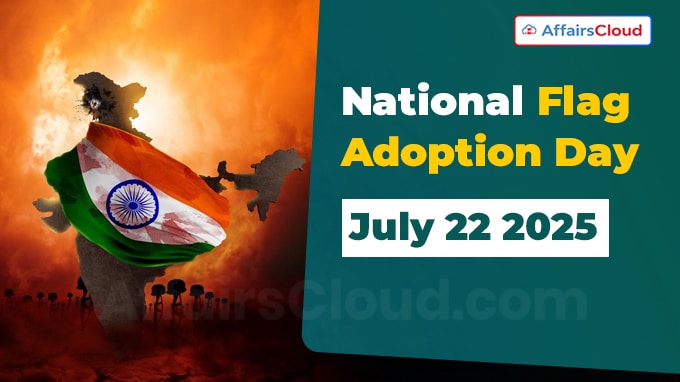 National Flag Adoption Day is annually observed across India on July 22 to commemorate the adoption of Trianga, the tricolour flag (the national flag of India) by the Constituent Assembly of India on July 22, 1947.
National Flag Adoption Day is annually observed across India on July 22 to commemorate the adoption of Trianga, the tricolour flag (the national flag of India) by the Constituent Assembly of India on July 22, 1947.
- The day honours the tricolour, which represents India’s struggle for freedom and its devotion to justice, liberty, and equality.
- July 22, 2025, marks the 78th anniversary of National Flag Adoption Day.
History of Indian National Flag:
i.The design of the Present Indian National Flag was inspired by the Swaraj Flag, which was first presented by Pingali Venkayya, a freedom fighter from Andhra Pradesh (AP), in 1921.
- The flag featured a horizontal colour of red, yellow, and green, with a white crescent and star in the centre.
ii.In 1921, Mahatma Gandhi proposed a new design featuring a spinning wheel (charkha) to symbolize progress and it also included the tricolour of saffron, white, and green.
- The spinning wheel or “Charkha” was replaced by Ashoka Chakra, designed by Badruddin Tyabji, the first Indian to practice as a Barrister of the High Court of Bombay.
iii.The Indian National Congress (INC) formally adopted the tricolour flag as its official flag, representing unity and diversity of India’s freedom movement in 1931.
iv.On July 22, 1947, the Constituent Assembly of India chaired by Dr. Rajendra Prasad adopted the National flag, featuring the tricolour of saffron white, and green with Ashoka Chakra in navy blue at its centre, which came prior to India’s Independence on August 15, 1947.
Features of India’s Tricolour Flag:
i.The Tricolour Flag, symbolizes the sovereignty, unity, and rich cultural heritage of India. The tricolour flag include:
- The saffron in the Top Band represents courage, sacrifice and spirit of renunciation.
- White in the Middle Band symbolizes peace, truth, and honesty, which provide balance and clarity.
- Green in the Bottom Band symbolizes faith, fertility, and the land’s prosperity.
- In the centre of the white Band is the Ashoka Chakra, a 24-spoke navy blue wheel derived from the Lion Capital of Ashoka, symbolizing eternal motion, progress, and righteousness.
ii.The ratio of length to width of the flag is 3:2.
Evolution of the Indian National Flag :
i.1904: Designed by Sister Nivedita (Irish social activist, disciple of Swami Vivekananda).
Colors: Red and yellow
Symbols: Vajra (strength), white lotus (purity)
Inscription: “Bande Mataram”
ii.1906 (Swadeshi Movement Flag):Known as the first tricolour
Hoisted in Calcutta
Colors: Green, yellow, red (horizontal stripes)
Symbols: Lotuses, sun, crescent moon
Inscription: “Vande Mataram”
iii.1907 (Saptarishi Flag):Hoisted by Madam Bhikaji Cama in Germany
Colors: Green, saffron, red
Symbols: Lotuses, sun, crescent moon
Inscription: “Vande Mataram”
iv.1917 (Home Rule Movement Flag):
Introduced by Annie Besant and Bal Gangadhar Tilak
Colors: Red and green stripes
Included: Union Jack, crescent and star, stars in Saptarishi pattern
Flag Code of India:
i.The Flag Code of India is a set of rules and guidelines that govern the use, display, and hoisting of the National Flag of India. It ensures the flag is respected, used with dignity and not dishonoured.
ii.On January 26, 2002, the Flag Code of India was modified and allowed the citizens of India to hoist the flags in their homes, offices on any day and not just on National Day as it was earlier.
iii.Flag Code of India was divided into three parts:
- Part I includes the general description of the National Flag
- Part II is dedicated to the display of the National Flag by members of the public, private organizations, educational institutions, etc.
- Part III describes the display of the National Flag by Central and State governments as well as their organizations and agencies.




